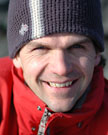Partner Profile: North Pacific Research Board—December 2007
In 1999, our executive director Julia Parrish was just starting COASST in Ocean Shores, Washington. During the Tenyo Maru oil spill, Julia had seen first hand the effects of pollution on coastal wildlife and realized that citizen science might be a great way to monitor beaches and create a baseline.
By the time COASST began collecting data, the North Pacific Research Board (NPRB) had been operational for two years. NPRB was created by Congress in 1997 in response to a nearly 20 year negotiation between the state of Alaska and the federal government over the stewardship of Alaska’s Arctic Coast.

Francis Wiese—Science Director of the North Pacific Research Board—soaks up a little sun out on the ski slopes. (Courtesy of F. Wiese)
On the other side of North America, Francis Wiese was initiating his graduate studies at Memorial University in Newfoundland, Canada, monitoring the impacts of chronic oil pollution on seabirds. Francis’ unique focus on using scientific data—in this case on the percentage of all beached birds found oiled—and the combination of industry and government agency partnerships resulted in positive changes in the Canadian environmental legislation pertaining to chronic oiling.
It was only a matter of time until these three paths converged. After graduating, Francis headed west to work with Julia as a postdoctoral fellow, researching the interactions between seabirds, salmon and hydroelectric dams on the Columbia River. Francis explains that their approach of working in conjunction with multiple stakeholders and using "solid science applied to a real world problem" was particularly appealing to him.
In 2005, Francis left the University of Washington to become a Program Manager at NPRB, quickly advancing to Science Director this year. Helping steer science and resource management in the largest state in the Union is a huge challenge. Francis describes the Alaskan environment as "vast, complex, and mostly out of reach," where the only realistic option is focusing on "things we can measure." This is where COASST re-enters the story.
NPRB sponsorship of COASST expansion into Alaska is now in its second year, with our Alaskan COASSTers surveying beaches from Sitka to the Pribilof Islands. "Nothing is more powerful in achieving the goal of ocean literacy than actually involving people directly in the research. Education and citizen science as promoted and implemented by COASST is a powerful means to achieve this."
"In the long-term, such a process builds the insurance that peoples’ interests are properly represented in the natural resource management arena." Francis acknowledges the "strength and success" of COASST lies in "merging solid science and citizen-based" data collection by coastal community residents from all walks of life. Because of NPRB support, our Alaskan participants are now an integral part of the more than 450 tenacious individuals from northern California to the Bering Sea who collectively set the gold standard for citizen scientists worldwide. And maybe we’ll even get Francis out on a beach!